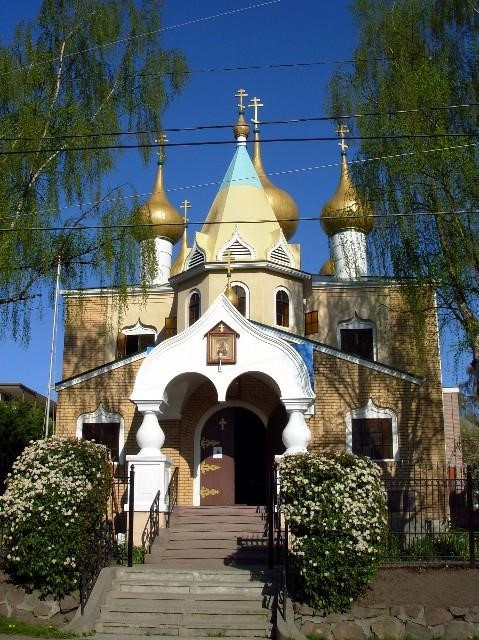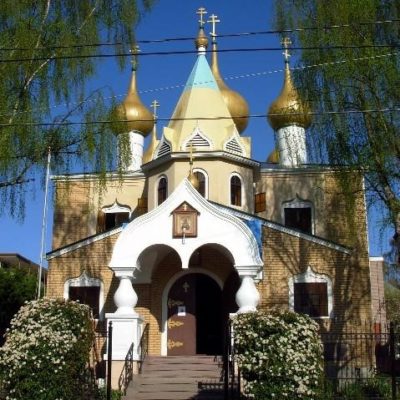Antiochian Orthodox Christian Archdiocese of North America

Introduction
The Antiochian Orthodox Christian Archdiocese of North America is under the authority of the Orthodox Christian Church.
The Orthodox
Christian Churches originate back to the 1st century and the city of Antioch. Antioch is the city where the disciples of Jesus Christ were first called to be His followers.
The Antiochian Orthodox
The Christian Archdiocese of North America believes they are called by God to worship and follow Him, and to proclaim and deliver to the world the message of love, peace, and salvation.
The Antiochian Orthodox Christian Archdiocese of North America is under the leadership of His Eminence Metropolitan Philip Saliba. Philip Saliba was born June 10, 1931 in Abou Mizan, Lebanon. He was educated in Tripoli Lebanon from 1945 to 1947; Homs, Syria from 1947 to 1949; Damascus Syria form 1949-1951; Nottinghamshire England 1953; London England in 1954; Boston Maryland in 1956; Detroit, Michigan from 1956 to 1969 and Crestwood, New York in 1965.
His Eminence Metropolitan Philip Saliba was ordained as a Deacon, August 6, 1949; as a Priest, March 1, 1959, by Metropolitan Antony Bashir. Archimandrite, June 1966, by Metropolitan Ilyas Kurban Archbishop, August 14, 1966, at St. Elias Monastery Lebanon, by Patriarch Theodosios VI; enthroned in New York October 13th 1966.
The Antiochian Orthodox Christian Archdiocese of North America is a member of SCOBA (Standing Conference of Canonical Orthodox Bishops of the Americas) and used to be a member of the National Council of Churches until July 28, 2005 when their convention unanimously voted to withdraw membership.
History
The Antiochian Orthodox Christian Archdiocese of North America is the only authority of the Church of Antioch in the USA and Canada.
The city of Antioch was the most essential city in the Roman Empire, especially during the time of the Apostles. It was the capital of the Roman province and ranked third in its importance. The Bible refers to Antioch in Acts 11:26 as being the place where the disciples of Jesus Christ were first called Christians. The church was formed after the death of St. Stephen and the persecution of his fellow followers in Christ. They assembled themselves for a whole year and formed a church. The followers of Jesus Christ preached the Word to the Jews who came from Cyprus, Cyrene, and the Grecians.
Antioch is in Syria on the river Orontes. It is about 16 miles from the Mediterranean Sea and about 300 miles north of Jerusalem. The first bishop of the Church of Antioch was St. Peter. Paul, Simeon, and Lucitus of Cyprene and Barnabas were sent to Antioch to preach in the land of the Gentiles to establish a tradition of missionaries (Acts 13). The conversion of Saul happened while Saul was on his way of Damascus Syria. The Lord instructed one of His disciples at Damascus, named Annia, to go into the street which is called Straight, and find Saul of Tarsus. Saul, who was later called Paul, was to be taken to the saints at Jerusalem because he was a chosen vessel unto Jesus. Paul was to bear the name of the Lord Jesus Christ before the Gentiles, kings and the children of Israel. (Acts 9).
The separation of Rome from Constantinople, Alexandria, Antioch and Jerusalem happened during the Great Schism of 1054. Rome was called the seat of the Patriarchate of the West, and Constantinople, Alexandria, Antioch and Jerusalem were called the Eastern Patriarchs. The Christians of Antioch were forced to join the Europeans who were immigrating to other countries in the late 19th century. Those who fled to North America first joined the Russian Orthodox Church.
The Antiochian immigrants in New York organized a Syrian Orthodox Benevolent Society in 1895. The first Orthodox bishop to be consecrated in North America was Raphael Hawaween a Russian clergyman. Father Raphael arrived in the United States on November 17, 1895 and died February 27, 1915. Father Raphael cared for the Orthodox Arabs in the United States and in Canada. It was through his efforts that the Antiochian Archdiocese was established. He established a parish in lower Manhattan for Syrian immigrants.
The First World War and the Bolshevik Revolution in Russia resulted in financial ruin to the Orthodox churches in North America. The Bolshevik Revolution also threw the Russian Orthodox Churches into total chaos and the unity of the Orthodox churches fell. There were many new movements that arose in every ethnic group and they started to divide into ecclesiastical factions.
The Antiochian Orthodox faithful in North America were divided into two main divisions. The archdioceses of New York and Toledo represented those loyal to the Church of Antioch and the Church of Russia. The second division of the Arabic faithful aligned with the Russian Metropolia who formed the American Orthodox Catholic Church and those who followed the Holy Synod of Antioch.
The Syrian Orthodox Benevolent Society was part of the conflict-ridden movement. The authority was restored again to the children of Antioch in North America in June 24, 1975. Some of the communities petitioned to remain under the authority of the Russian Church while others petitioned to remain under the authority of the Patriarchate of Antioch. Metropolitan Philip Saliba of the Antiochian Archdiocese of New York and the Metropolitan Michael Shaheen of the Antiochian Archdiocese of Toledo, Ohio, signed the articles of Reunification to restore unity among all the Antiochian Orthodox Christians in the United States and Canada. Metropolitan Philip became the primate of the newly reunified archdiocese, and Metropolitan Michael became an auxiliary archbishop.
Belief
The Antiochian Orthodox Christian Archdiocese of North America believe God loves all mankind. They believe God wants mankind to believe in Him, know Him, abide in Him, and receive eternal life from Him. God Himself came into the world as a man, Jesus Christ, to achieve this goal. They follow the Nicene Creed which is also called the Constantinopolitan creed.
Constantinopolitan (Nicene) Creed
“We believe in one God, the Father Almighty, Maker of heaven and earth, and of all things visible and invisible; And in one Lord, Jesus Christ, the Son of God, the Only-begotten, Begotten of the Father before all ages, Light of Light, True God of True God, Begotten, not made, of one essence with the Father, by Whom all things were made: Who for us men and for our salvation came down from heaven, and was incarnate of the Holy Spirit and the Virgin Mary, and was made man; And was crucified also for us under Pontius Pilate, and suffered and was buried; And the third day He rose again, according to the Scriptures; And ascended into heaven, and sitteth at the right hand of the Father; And He shall come again with glory to judge the living and the dead, Whose kingdom shall have no end. And we believe in the Holy Spirit, the Lord, and Giver of Life, Who proceedeth from the Father, Who with the Father and the Son together is worshipped and glorified, Who spoke by the Prophets; And we believe in One, Holy, Catholic and Apostolic Church. We acknowledge one Baptism for the remission of sins. We look for the Resurrection of the dead, And the Life of the age to come. Amen.”
Cite Article Source
MLA Style Citation:
Holstein, Joanne “Antiochian Orthodox Christian Archdiocese of North America.” Becker Bible Studies Library Jan 2006.<https://guidedbiblestudies.com/?p=2574,>.
APA Style Citation:
Holstein, Joanne (2006, January) “Antiochian Orthodox Christian Archdiocese of North America.” Becker Bible Studies Library. Retrieved from https://guidedbiblestudies.com/?p=2574,.
Chicago Style Citation:
Holstein, Joanne (2006) “Antiochian Orthodox Christian Archdiocese of North America.” Becker Bible Studies Library (January), https://guidedbiblestudies.com/?p=2574, (accessed).

